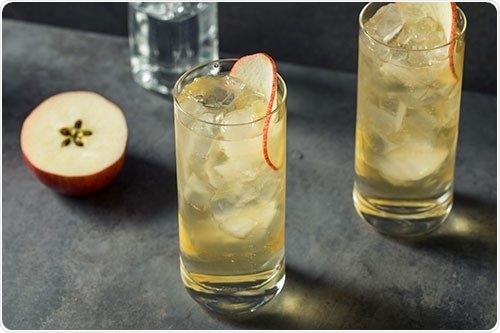The holiday season is marked with celebrations and festive drinks—some made with apple liquors. These traditional spirits have a great history, however, decisions about their processing are still subjectively decided.

The quality and taste of apple spirits could be improved by measuring their conductivity during distillation. Image Credit: Brent Hofacker/Shutterstock.com.
Recently scientists revealed that evaluating the liquor’s conductivity can offer a more objective evaluation, and they also identified a way to make the process more energy-efficient. The study was published in the ACS Food Science & Technology journal.
Apples were used as a good base for liquors, like Applejack in the United States and the Calvados in France as they are loaded with sugar and desirable flavors. The mashed fruit ferments to produce alcohol along with additional flavor compounds. This adds to the complex taste of the final liquor.
When the fermented apples are distilled with heat, the alcohol gets concentrated and the unpleasant fermentation by-products like carboxylic acids that impart rancid, unclean, sweaty, and cheesy flavors are removed. Producers normally use batch columns to produce apple spirits as it offers a clean-tasting, high-alcohol distillate in a huge volume.
However, the precise time to halt the distillation process—and accomplish the most flavorful liquor—was uncertain to date. Andreas Liebminger and coworkers earlier demonstrated that a rapid increase in apricot brandy distillate’s conductivity reliably shows the ideal time to halt distillation. The scientist wanted to observe if the same holds for apple liquors.
The scientists crushed and fermented apples into a mash which was later distilled in a German-style batch column still. The mash was then heated and the researchers continuously watched the conductivity of the distillates and analyzed the levels of nine carboxylic acids. The researchers discovered that with the increase in conductivity, the levels of the bad-tasting carboxylic acids also increased.
They carried out additional tests to determine a more energy-efficient distillation strategy and found that heating the mash too quickly resulted in a distillate with a lesser conductivity and fewer of the unwanted flavor compounds, however, its smell was bland.
On the other hand, increasing the temperature of the still’s cooling tower resulted in liquor with a good aroma intensity, and also reduced carboxylic acid levels. Keeping the cooling tower a few degrees warmer did not expend much energy when compared to the traditional approach.
According to the scientists monitoring the conductivity in the distillates provided them with an easy way to determine the better conditions for making apple spirits with the most desirable taste and quality.
Source:
Journal reference:
Liebminger, A., et al. (2021) Monitoring of Carboxylic Acids by In-Line Conductivity Measurement to Determine Optimum Distillation Strategy for Distilling Apple Spirits. ACS Food Science & Technology. doi.org/10.1021/acsfoodscitech.1c00327.